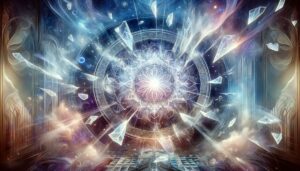Dreams have always captivated humanity, cloaked in mystery and laden with the whispers of our subconscious minds. Whether they offer a peek into our deepest fears or frame our loftiest aspirations, understanding the nature of dreams can shine a light on the darker corners of our inner lives. This article aims to unravel the different categories of dreams and discover their unique qualities and meanings.
The First Type: Lucid Dreams
Lucid dreams are a phenomenon that turns the concept of dreaming on its head. In these dreams, rather than wandering through the shadows of the subconscious unwittingly, dreamers become aware that they're in a dream. This awareness can range from a faint recognition of the dream state to a profound ability to control the dream’s environment.
- Characteristics of Lucid Dreams:
- Awareness that one is dreaming.
- Possible control over the dream’s narratives and environment.
- Enhanced clarity and vividness.
Lucid dreaming can serve various purposes, from offering an escape from reality to serving as a unique tool for problem-solving. The ability to manipulate dream scenarios can help creatively solve problems in waking life or provide therapeutic benefits, like overcoming nightmares.
- Techniques to Induce Lucid Dreams:
- Regular reality checks (e.g., checking whether digital clocks display time consistently).
- Mnemonic induction of lucid dreams (MILD), which involves waking up after five hours of sleep and then developing the intention to remember being in a dream during subsequent sleep.
Lucid dreams not only entertain but also provide a rare opportunity for introspection and personal development.
The Second Type: Nightmares
Nightmares are more than just bad dreams. They are vividly realistic, disturbing dreams that can rattle you awake from a deep sleep, and they often leave lingering feelings of fear or distress.
- Characteristics of Nightmares:
- Intense fear or horror.
- Sudden awakenings from sleep.
- Possible recall of the unsettling dream content.
Several factors may contribute to nightmares:
- Causes of Nightmares:
- Psychological stress or anxiety.
- Trauma or adverse experiences.
- Side-effects of medications or substance abuse.
Despite their unsettling nature, nightmares may have a protective purpose. They play a pivotal role in helping us process emotions and adapt to life's stresses.
- Managing Nightmares:
- Establishing a soothing bedtime routine.
- Limiting exposure to disturbing content before sleep.
- Therapy techniques such as imagery rehearsal therapy (IRT), where sufferers reimagine the nightmare's outcome while awake, to lessen its impact during sleep.
The Third Type: Ordinary Dreams
Unlike the intense scenarios of lucid dreams and nightmares, ordinary dreams are those we experience most frequently. They might not have the vividness and emotional depth as the other types, but they play a vital role in our cognitive functions.
- Characteristics of Ordinary Dreams:
- Often forgotten upon waking.
- Influenced by daily activities, interactions, or passive thoughts.
These dreams serve as a canvas where the mundane moments of our daily lives find expression in abstract or narrative forms. Here’s how they interact with our daily lives:
- Functions of Ordinary Dreams:
- Processing daily experiences and emotions.
- Facilitating learning and memory integration.
- Inspiring creativity.
The simplicity of ordinary dreams often belies their importance in maintaining mental and emotional equilibrium.
Sleep Stages and Dream Types
Understanding when different types of dreams occur requires a basic knowledge of sleep stages. Sleep is divided into rapid eye movement (REM) and non-rapid eye movement (NREM) stages.
- Association Between Dream Types and Sleep Stages:
- Lucid dreams and nightmares often occur during REM sleep when the brain is most active.
- Ordinary dreams can occur during both REM and NREM sleep but are often less vivid during NREM stages.
The neural correlates of dreaming reveal that different sleep stages engage various areas of the brain, thus influencing the type of dreams experienced. Here’s a glimpse at the distinct patterns:
- Neural Activity Patterns:
- REM sleep shows heightened activity in areas related to emotion and vivid imagery.
- NREM sleep involves more scattered and less intense neural firing, which may explain the less vivid nature of dreams during these stages.
Incorporating Images:
Here is a visualization of how lucid dreams might be induced and experienced:
And here's an image depicting common nightmare scenarios and their potential interpretations:
Understanding these patterns helps not only in comprehending how dreams form but also provides insights into the broader scope of human psychology and sleep biology.
Theories Behind Dreaming
Let's dive deeper into the swirling currents of dream theories that have intrigued scientists and psychologists alike for centuries. The study of dreams opens up conversations spanning from Freud’s psychoanalytic perspectives to cutting-edge neurological research, all aimed at understanding the enigmatic world of our subconscious.
Freudian and Jungian Perspectives
Dreams have long been seen as a window into our unconscious desires and fears. Sigmund Freud posited that dreams are the royal road to the unconscious, helping us to resolve repressed conflicts and desires through symbolic language. Carl Jung, on the other hand, introduced the concept of archetypes and collective unconscious, suggesting that dreams tap into universal symbols shared across humanity, offering insights into personal development and growth.
Neurobiological Explanations
The activation-synthesis hypothesis offers a strikingly different view, suggesting that dreams are merely a byproduct of brain activity as it synthesizes and interprets random signals during sleep. According to this theory, dreams don't necessarily have inherent meanings but are subjective interpretations of these random signals.
Evolutionary Perspectives
Some evolutionary psychologists view dreaming as a kind of mental simulation that prepares individuals to face real-life threats and challenges, enhancing survival skills through the rehearsal of potential scenarios. This perspective sees the dream experience as a virtual reality where one can safely practice responses to complex social and environmental challenges.
Dreaming is not just an idle brain activity but a dynamic interplay between our physiological states and psychological needs. By understanding these theories, we can appreciate dreams not merely as night-time narratives but as powerful reflections of our waking life and evolutionary demands.
Understanding and Interpreting Your Dreams
Dreams can sometimes feel like a tangled web of surreal scenarios, but they hold the potential for profound self-awareness and insight. By recognizing and interpreting the patterns in our dreams, we can uncover aspects of our subconscious mind that influence our thoughts, behaviors, and feelings in waking life.
Why Journaling Matters
Keeping a dream journal can vastly improve your ability to recall and interpret dream details. Note down as much as you can upon waking:
- Key scenes and symbols
- Emotions felt during the dream
- Characters and interactions
Gaining Psychological Insights
Regular dream analysis can reveal recurrent themes or issues, facilitating deeper understanding and personal growth. It serves as a mirror reflecting our innermost fears, desires, and conflicts, helping us address or reconcile them in our conscious life.
Dreams are a dialogue with the self; listening could enrich your psychological and emotional landscape significantly. Encourage yourself to explore dream journaling as a pathway to self-discovery.
Cultural and Individual Variations in Dream Experiences
Dreams are not a one-size-fits-all phenomenon. They are deeply personal yet universally experienced, woven with the threads of cultural and individual contexts that color their interpretation and significance.
Cultural Interpretations
Across the globe, dreams are interpreted through various cultural lenses. In some cultures, dreams are considered prophetic, containing messages from the divine or insights into future events. In others, they might be viewed as mere echoes of daily life. Understanding these cultural differences enriches our perspective on how human values, fears, and visions are intricately linked to the dream experience.
Personal Dream Narratives
Every individual’s dream landscape is unique, shaped by their experiences, emotions, and environment. This personal dream narrative provides valuable introspection opportunities:
- How do your dreams reflect your personal fears or desires?
- What can your most vivid dreams tell you about your emotional state?
Exploring these questions can deepen your understanding of self and contribute to broader cultural discussions about the meanings and implications of our dream worlds.
Conclusion
Through the winding paths of dream types and theories, we've glimpsed into the rich tapestry that constitutes our dreaming life. Recognizing the different types of dreams and their unique properties opens up new avenues for personal and psychological exploration. Armed with this knowledge, you might find yourself viewing each dream as a chapter in the ongoing story of your inner world—a story worth understanding and cherishing.
Dreams not only whisper to us in the silence of the night but also echo in the clarity of the day. Let them guide, teach, and reveal the depths of your subconscious as you continue to explore the enigmatic world of sleep and dreams.
Feel free to share your personal dream experiences or insights in the comments below! We'd love to hear how your dreams have shaped your understanding of your inner world.
(Include this image depicting personal growth through dream analysis and spiritual practices.)







0 Comments